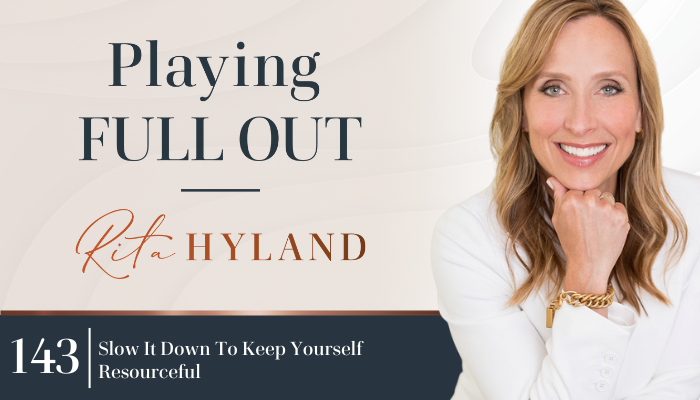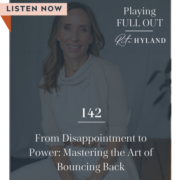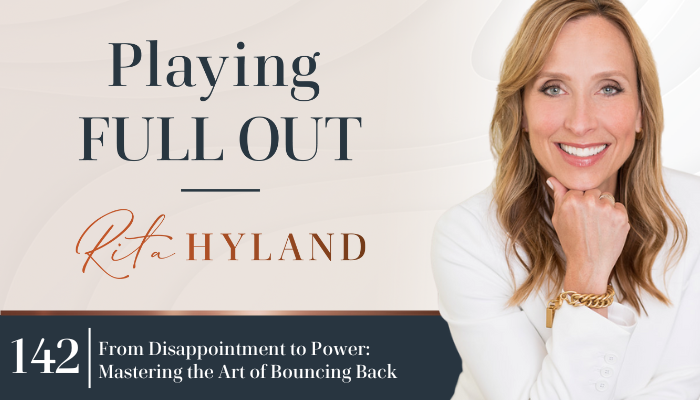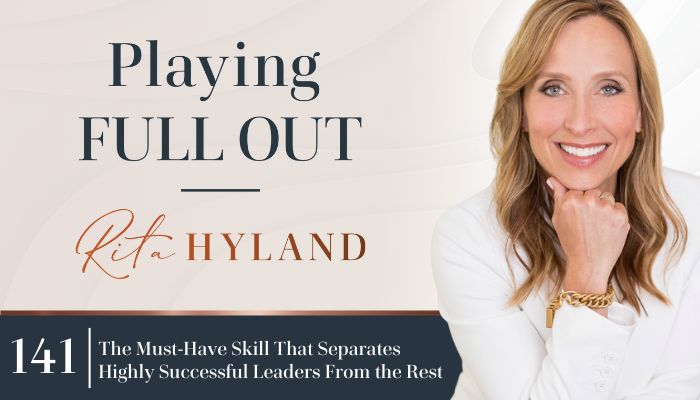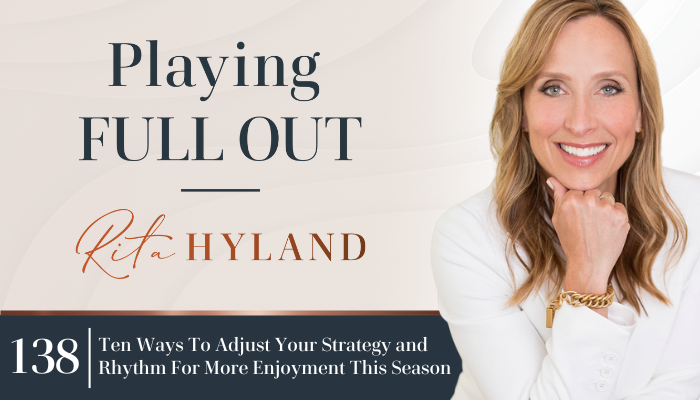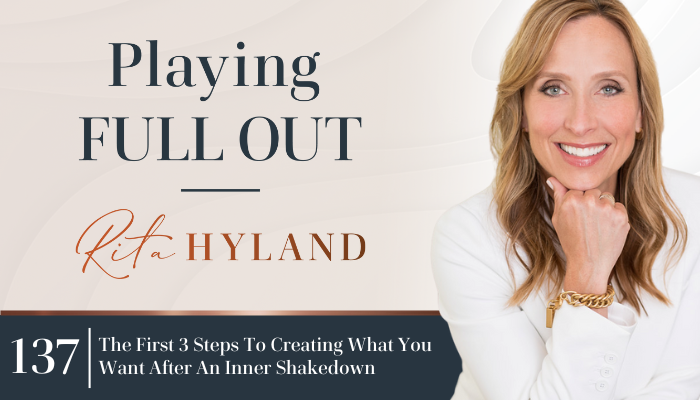The Hidden Cost Behind Having It All Together: What High-Performers Rarely Admit But Deeply Feel

Listen to the full podcast episode to learn about the science-backed practice that has not only changed my life but also the lives of countless people over the last two decades. This is something you can’t ignore if you want to achieve that great goal you identified for this year and write your new future.
You’ve achieved everything you were supposed to: a successful career, a full family life, the ability to get things done. And yet, you find yourself asking… Why don’t I feel more satisfied? Why am I still not at peace? Why can’t I rest better?
In this deeply personal episode of Playing Full Out, I step away from the quick tips and high-performance tools to share the truths we often don’t talk about—the emotional toll of always being “on,” the subconscious fear of not being enough, and the secrets we keep even from ourselves in the name of success.
The Hidden Pressure Behind High Achievement
For many high achievers, life looks nearly perfect from the outside. Having everything we once dreamed of: a thriving career, a beautiful home, and happy kids. But beneath the surface, there is a quiet, persistent restlessness that rarely gets resolved.
As I was years ago, I was unknowingly governed and directed by a deep insecurity of “not being enough.” I couldn’t see it at the time. All I knew was that I was always on, always doing, always striving; in short, I was obsessed. I was working so hard to maintain an image and avoid uncomfortable truths that I didn’t even see.
What I didn’t realize was that I was burning myself out. I wasn’t lying outright, but I was performing a version of myself that wasn’t true. The one thing I never wanted to be called? “Average.” That one word revealed the secret I worked overtime to hide.
And I see the same pattern in my clients: men and women running successful businesses, raising beautiful families, and hosting perfect holiday parties, yet underneath, they’re exhausted, overextended, and quietly wondering, ‘Why don’t I feel better?’
The Toll of Avoiding Discomfort
What lies at the crux of running at this exhausting pace? It’s not the workload. It’s not the job. It’s not even the stress. It’s the unconscious fear that if we slow down, we’ll fall apart, or if we slow down, we won’t be seen.
These burdens don’t always show up as obvious thoughts. Instead, they creep in as perfectionism, chronic anxiety, or a constant urge to keep everyone around you happy. And here’s the hard truth. The hiding, the not knowing, and then the not telling once we do know that is what causes the pain. The secret itself isn’t the problem; it’s the ongoing effort to keep the secret hidden.
What it Takes to Find True Peace
One of my clients, Michelle, had just sold her company. On paper, she had everything she set out to accomplish. But instead of feeling free and at peace, she felt anxious, lost, and restless. What we discovered was that her worth had been tied to her hustle. Without it, she didn’t know who she was. She didn’t believe she was worthy of love or rest without first proving her value.
That belief was what created the restlessness, and it’s a story I’ve seen over and over again.
You see, sustainable peace doesn’t come from a new schedule. It comes from telling the truth to ourselves first. From releasing the identities, we’ve built a sense of safety, allowing ourselves to grieve, rage, and feel what’s been buried.
When I did this work myself, everything shifted. When I decided to reveal my secret, I experienced a peace I had never felt before. My business grew, my health improved, and ironically, I got more done by doing less. That’s the power of aligning with your true self, rather than the image you think you have to be.
Questions to ask yourself in finding true peace
If you are ready to begin your journey of uncovering your inner secrets and finding true peace, here are some reflection questions to get you started:
- What secrets am I keeping, even from myself?
- What emotions am I avoiding by staying busy?
- What rules have I created just to feel safe, and do they still serve me?
- If someone wrote an article about me tomorrow, what’s the last word I would not let them call or say about me? Then, look at what you do in a day to avoid being called that word.
The Marks of Real Healing
Real healing doesn’t begin with a hack. It doesn’t begin with a tool, years of deep therapy, or dramatic life overhauls. Simply acknowledging what’s long been avoided, naming it, writing about it, or speaking it out loud, even privately, begins to release its grip. Over time, triggers that once sent us into anxiety or frustration lose their charge. The pursuit of rest and ease shifts away from external hacks and toward more profound self-awareness.
Peace isn’t about what we do but who we’re willing to become as we move through life. By meeting ourselves honestly, we finally create the rest, joy, and fulfilment that achievement alone could never bring.
Remember, peace is always available when we stop hiding from ourselves.
In this episode, I share:
- The hidden cost of constantly being busy and how our restlessness masks deeper secrets and fears.
- How protective habits become harmful patterns that leave us stuck and depleted.
- How to find true peace and rest beyond the meditation app and productivity hacks.
Resources and related episodes:
- Tune in to the previous episode, The Second Thought Method
- Listen to Leading From a Heart at Peace
- If you’d like to be notified of when new podcast episodes are released, you can do so here: Playing Full Out
- Learn more about the Inside Out Method
- Connect with Rita on LinkedIn
Subscribe on Apple Podcasts for more tips, tools, and inspiration to lead the optimal vision of your life, love, and leadership. Remember, a half version of you is not enough. The world needs the fullest version of you at play.
___
About Rita Hyland
With over 20 years of experience as an executive and leadership coach, Rita helps leaders — emerging and established — excel in corporate and entrepreneurial environments.
Rita believes if leaders were more clear about how transformation really works and more intentional about creating what they want, their impact, success, and influence in the world would be unstoppable.
Through her coaching programs, private coaching, and masterminds, Rita shows leaders how to win consistently and create the impact and legacy they desire.
Central to Rita’s work is the understanding that you will never outperform your current programming, no matter how strong your willpower.
When you learn to use Rita’s proprietary Inside Out Method, a technology that uses the best of neuroscience and transformational psychology to hit the brain’s buttons for change, YOU become both the solution and the strategy.
Her mission is to end talented, hard-working, and self-aware leaders spending another day stuck in self-doubt or confusion and not contributing their brilliant work and talent the world so desperately needs.





